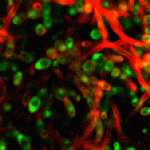Link to Pubmed [PMID] – 19151323
Eukaryotic Cell 2009 Apr;8(4):550-9
The ability of Candida parapsilosis to form biofilms on indwelling medical devices is correlated with virulence. To identify genes that are important for biofilm formation, we used arrays representing approximately 4,000 open reading frames (ORFs) to compare the transcriptional profile of biofilm cells growing in a microfermentor under continuous flow conditions with that of cells in planktonic culture. The expression of genes involved in fatty acid and ergosterol metabolism and in glycolysis, is upregulated in biofilms. The transcriptional profile of C. parapsilosis biofilm cells resembles that of Candida albicans cells grown under hypoxic conditions. We therefore subsequently used whole-genome arrays (representing 5,900 ORFs) to determine the hypoxic response of C. parapsilosis and showed that the levels of expression of genes involved in the ergosterol and glycolytic pathways, together with several cell wall genes, are increased. Our results indicate that there is substantial overlap between the hypoxic responses of C. parapsilosis and C. albicans and that this may be important for biofilm development. Knocking out an ortholog of the cell wall gene RBT1, whose expression is induced both in biofilms and under conditions of hypoxia in C. parapsilosis, reduces biofilm development.



